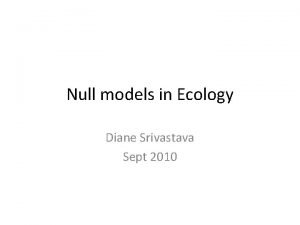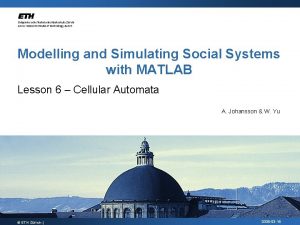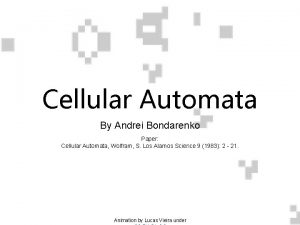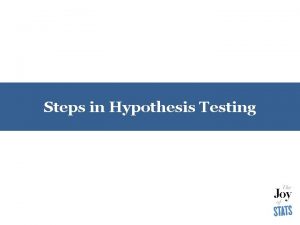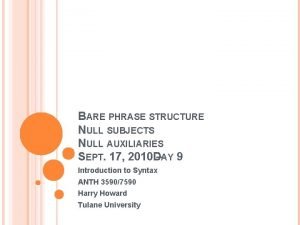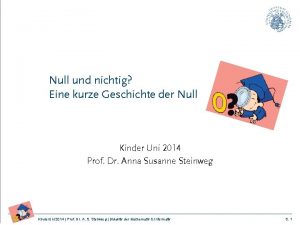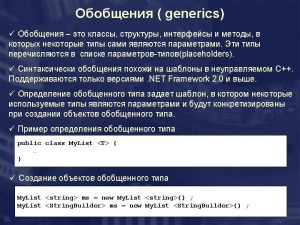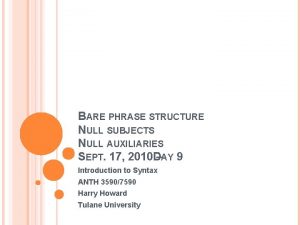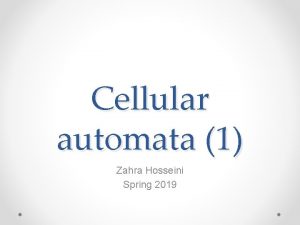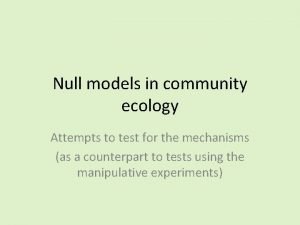Cellular automata models Null Models for Ecology Jane
















































- Slides: 48

Cellular automata models : Null Models for Ecology Jane Molofsky Department of Plant Biology University of Vermont Burlington, Vermont 05405

Cellular automata models and Ecology • Ecological systems are inherently complex. • Ecologists have used this complexity to argue that models must also be correspondingly complex

Cellular automata models in Ecology • Search of ISI web of science ~ 64 papers • Two main types – Empirically derived rules of specific systems – Abstract models – Many more empirical models of specific systems than abstract models

1 -dimensional totalistic rule of population dynamics • Individuals interact primarily locally • Each site is occupied by only one individual • Rules to describe transition from either occupied or empty • 16 possible totalistic rules to consider Molofsky 1994 Ecology

Ecological Scenarios • Two types of competition – Scramble – Contest • Two scales of dispersal – Local – Long

Possible neighborhood configurations 0 0 1 1 1 0 1 1 Sum 0 0 1 0 2 1 1 1 3

Transition Rules Sum Local Dispersal Long distance Dispersal 0 1 2 3 0 1 1 1 0

Long distance dispersal

Local Dispersal

Totalistic Rule Set Contest Scramble 2 states, nearest neighbors 28 or 256 possible rules

Totalistic Rule Set • How often we expect complex dynamics to occur? – Ignore the 2 trivial cases – 6/14 result in “chaos”, 6/14 periodic, 2/14 fixation • How robust are dynamics to changes in rule structure?

Totalistic Rule Set Contest Scramble 2 states, nearest neighbors 28 or 256 possible rules

Do plant populations follow simple rules? 1 -dimensional experimental design Grown at 2 different spacings (densities) Cardamine pensylvanica Fast generation time No seed dormancy Self-fertile Explosively dispersed seeds Molofsky 1999. Oikos

Do plant populations follow simple rules? • In general, only first and second neighbors influenced plant growth. • However, at high density, long range interactions influenced final growth

Experimental Plant Populations Replicated 1 -dimensional plant populations Followed for 8 generations Fast generation time No seed dormancy Self-fertile Explosively dispersed seeds

Two dimensional totalistic rule • • • Two species 0, 1 von Neumann neighborhood Dynamics develop based on neighborhood sum 64 possible rules Rules reduced to 16 by assuming that when only 1 species is present ( i. e sum of 0 or 5), it maintains the site the next generation • 16 reduced to 4 by assuming symmetry

Rule system Species 0 Species 1 1 4 2 3 3 2 4 1 Positive 0 0 1 1 Negative 1 1 0 0 Allee effect 0 1 Modified Allee 1 0

Biological Scenarios Positive Frequency Dependence Negative Frequency Dependence Allee effect

System Behavior 00 01 1, 0 P 1= probability that the target cell becomes a 1 given that the neighborhood sum equals 1 periodic Ergodic (0. 2, 0. 4)”Voter rule” P 2 clustering Phase separation 0, 0 P 2= probability that the target cell becomes a 1 given that the neighborhood sum equals 2 0, 1 P 1 00 10 Molofsky et al 1999. Theoretical Pop. Biology

0. 98, 0. 98 0. 27, 0 0. 31, 0 0. 35, 0 D. Griffeath, Lagniappe U. Wisc. Pea Soup web site

Frequency dependence Dispersal Probability that the migrant establishes: H 1=0. 5 + a (F 1 -0. 5) Probability that a migrant of species 1 arrives on the site Neighborhood shape Probability that a site is colonized by species 1 Moore neighborhoood

Positive frequency dependence Molofsky et al 2001. Proceedings of the Royal Society

Spatial Model Stochastic Cellular Automata One individual per grid cell Determine the probability that a species colonizes a cell Update all cells synchronously

Transition Rule Frequency dependence Probability that a site is colonized by species 1 Probability that the migrant establishes h 1=0. 5 + a (f 1 -0. 5) Dispersal Probability that a migrant of species 1 arrives on the site P 1 = h 1 f 1/(h 1 f 1 + h 2 f 2+ h 3 f 3+ h 4 f 4+ h 5 f 5+ h 6 f 6+ h 7 f 7+ h 8 f 8+ h 9 f 9+ h 10 f 10 )

1. The neutral case 2. (a=0) Ecological Drift sensu Hubbell 2001

2. Positive Frequency (a=1) Generation 0 Generation 100, 000 Molofsky et al 2001. Proc. Roy. Soc. B. 268: 273 -277.

3. Positive Frequency 20 % unsuitable habitat Generation 0 Generation 100, 000

4. Positive Frequency Dependence 40% unsuitable habitat Generation 0 Generation 100, 000

The Burren

Interaction of the strength of frequency dependence and the unsuitable habitat Number of species after 100 000 generations Molofsky and Bever 2002. Proceedings of the Royal Society of London

Invasive species Local interactions: Yes, reproduces clonally Exhibits positive frequency dependence: Yes High levels of diversity: Yes No obvious explanation: Yes Lavergne, S. and J. Molofsky 2004. Critical Reviews in Plant Sciences

Consideration of spatial processes requires that we explicitly consider spatial scale Each process may occur at its own unique scale

Competition may occur over short distances but dispersal may occur over longer distances Grazing by animals in grasslands may occur over long distances while seed dispersal occurs over short distances

Negative frequency dependence Two species, two processes dispersal frequency dependence Probability that the migrant establishes: H 1=0. 5 + a (F 1 -0. 5) Probability that a site is colonized by species 1 Probability that a migrant of species 1 arrives on the site

Each process can occur at a unique scale Interaction neighborhood D 1 F 1 Dispersal neighborhood Focal site Molofsky et al 2002 Ecology

Local Frequency Dependence Local Dispersal Weak Frequency Dependence a = - 0. 01 Intermediate Frequency Dependence a = -0. 1 Strong Frequency Dependence a = -1

For local interactions when frequency dependence is strong (a = -1) random patterns develop because H 1 = 1 - F 1, D 1 = F 1 P 1 = (1 - F 1 ) , F 1 / (1 - F 1 ) , F 1 + F 1 (1 - F 1 ) = (1 - F 1 ) , F 1 / 2( (1 - F 1 ) , F 1 ) = 0. 5

Weak Frequency Dependence a = -0. 01 Dispersal and Frequency Dependence at same scale Local Dispersal Local Frequency Dependence Long Dispersal Long Frequency Dependence

Local Frequency Dependence Long Distance Dispersal Strong Frequency Dependence a=-1 Weak Frequency Dependence a = - 0. 01

Why bands are stable? Local, strong, frequency dependence (over the large dispersal scale, the two species have the same frequency: D 1=D 2) Because the focal, blue, cell is mostly surrounded by yellow, is stays blue

Local Dispersal Long Distance Frequency Dependence Strong Frequency Dependence a=-1 Weak Frequency Dependence a = - 0. 01

Why bands are stable? Local dispersal (over the large interaction scale, the two species have the same frequency: H 1=H 2) Because the focal, blue, cell is mostly surrounded by yellow, is becomes yellow

How robust are these results? Boundary Conditions Torus, Reflective or Absorbing Interaction Neighborhoods Square or Circular Updating Synchronous or Asynchronous Disturbance Habitat Suitability

Effect of Disturbance Strong Frequency Dependence a = -1 Disturbance = 25 % of cells Local Frequency Dependence Long Distance Dispersal Local Dispersal Long Distance Frequency Dependence

Habitat Suitability Strong Frequency Dependence a = -1 25 % of cells are unsuitable Local Frequency Dependence Long Distance Dispersal Local Dispersal Long Distance Frequency Dependence

Processes that give rise to patterns… Strong Negative Frequency Dependence only if equal scales Weak Negative Frequency Dependence only if long distance dispersal Weak Negative Frequency Dependence only if dispersal is local Weak Positive Frequency Dependence only if dispersal is local Strong Negative Frequency Dependence only if unequal scales Strong Positive Frequency Dependence most likely if local scales only

Negative frequency dependence If dispersal and frequency dependence operate over different scales, strong patterning results Striped patterns may explain sharp boundaries between vegetation types Need to measure both the magnitude and scale of each process

Next step • Non symmetrical interactions • For non-symmetrical interactions, what is necessary for multiple species to coexist? Most multiple species interactions fail but we can search the computational universe and ask, which constellations are successful and why?
 Null models in ecology
Null models in ecology Cellular automata matlab
Cellular automata matlab Strategi för svensk viltförvaltning
Strategi för svensk viltförvaltning Varians formel
Varians formel Datorkunskap för nybörjare
Datorkunskap för nybörjare Tack för att ni har lyssnat
Tack för att ni har lyssnat Treserva lathund
Treserva lathund Ekologiskt fotavtryck
Ekologiskt fotavtryck Läkarutlåtande för livränta
Läkarutlåtande för livränta Påbyggnader för flakfordon
Påbyggnader för flakfordon Tack för att ni lyssnade
Tack för att ni lyssnade Egg för emanuel
Egg för emanuel Atmosfr
Atmosfr Personlig tidbok
Personlig tidbok Rutin för avvikelsehantering
Rutin för avvikelsehantering Var finns arvsanlagen
Var finns arvsanlagen Byggprocessen steg för steg
Byggprocessen steg för steg Rådet för byggkompetens
Rådet för byggkompetens Kontinuitetshantering i praktiken
Kontinuitetshantering i praktiken Myndigheten för delaktighet
Myndigheten för delaktighet Presentera för publik crossboss
Presentera för publik crossboss Kung som dog 1611
Kung som dog 1611 Tobinskatten för och nackdelar
Tobinskatten för och nackdelar Tack för att ni har lyssnat
Tack för att ni har lyssnat Boverket ka
Boverket ka Referatmarkering
Referatmarkering Start för skala
Start för skala Epiteltyper
Epiteltyper Varför kallas perioden 1918-1939 för mellankrigstiden
Varför kallas perioden 1918-1939 för mellankrigstiden Arkimedes princip formel
Arkimedes princip formel Multiplikation uppställning
Multiplikation uppställning Elektronik för barn
Elektronik för barn Borra hål för knoppar
Borra hål för knoppar Anatomi organ reproduksi
Anatomi organ reproduksi Smärtskolan kunskap för livet
Smärtskolan kunskap för livet Bris för vuxna
Bris för vuxna Mat för unga idrottare
Mat för unga idrottare Novell typiska drag
Novell typiska drag Frgar
Frgar Jiddisch
Jiddisch Magnetsjukhus
Magnetsjukhus Ellika andolf
Ellika andolf Blomman för dagen drog
Blomman för dagen drog Steg för steg rita
Steg för steg rita Mall för debattartikel
Mall för debattartikel Redogör för vad psykologi är
Redogör för vad psykologi är Ramsa geometriska former
Ramsa geometriska former Bästa kameran för astrofoto
Bästa kameran för astrofoto En lathund för arbete med kontinuitetshantering
En lathund för arbete med kontinuitetshantering
